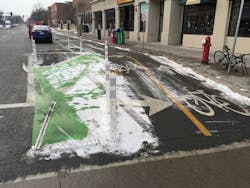In 2010, Bicycling Magazine named Minneapolis, Minn., as the No. 1 bike city in the U.S.
The publication went on to say that the unforgiving and frigid Midwestern city is the country’s top spot to be an urban cyclist. Now we just have to figure out why. When I heard about that, I thought to myself, “How did that happen?”
Since then, Minneapolis continues to be recognized internationally as a bicycle-friendly city, which was part of the World Cycling Federation’s decision to hold its fourth, and first in the U.S., Winter Cycling Congress (WCC) in Minneapolis-St. Paul in February 2016. While that recognition is nice, it also brings with it high levels of expectation from the public and bicycling advocates alike, questions about long-term operation and maintenance, design issues never before contemplated, and challenges and costs regarding maintenance. To explore all this, the first step is to briefly look at the vision for protected bikeways in Minneapolis, then look at one particular new facility over its first year, including design, construction and a year of maintenance experience. Other facilities, equipment, procedures and budgeting will be explored as well.
Minneapolis has long boasted a well-established system of recreational trails. A 2013 Climate Action Plan report first called for 30 miles of on-street protected bicycle facilities by 2020. In 2016, Minneapolis, like cities across the nation, adopted a Complete Streets Policy that turned the modal priorities framework on its head. The commitment to promote increased bicycling has resulted in the miles of bicycling facilities in Minneapolis nearly doubling to 102 miles in the last 10 years, including 6.4 miles of protected bikeways installed in 2015 alone. One of those projects was the Oak Street Southeast project.
Maintenance barrier
Oak Street SE is an arterial street that cuts through the University of Minnesota campus in Minneapolis, and is a major connection between the Mississippi River trail system and the heart of campus. The original section is about four blocks long, had two vehicular lanes in each direction, was a high-demand route (1,110 bicyclists per day) that unfortunately had no bike lanes, and had parking on both sides through much of the corridor. Design goals strove to preserve as much of the existing parking as possible and provide better access for all modes to campus destinations. In order to build many miles quickly, the city standard for vertical separation is: tube delineators (or just delineators), bollards, channelizers, posts, pedestals, candlesticks, or maintenance crew’s descriptor of choice, “hit sticks.” The Oak Street solution was to offset the parking away from the curb on one side, and separate with the standard vertical buffer on the north end and a permanent concrete curb section on the south. A two-way bike lane was placed between the curb and the parking lanes. While that satisfied community and design goals, it introduced some challenges for maintenance crews.
Once the project was complete and operational, maintaining this rather nontraditional facility, as well as other new systems, in both summer and winter had to be addressed. While there were many factors at play, including sweeping and cleaning, signing, striping, pavement markings, lighting, delineator replacement and pavement maintenance, this discussion will focus on snow and ice control.
The first problem is that, particularly with narrow or one-way lanes, traditional equipment will often not fit, requiring investment in new equipment or costly modifications to existing equipment, in order to accomplish tasks. New procedures need to be created; levels of service have to be realistic. Vertical delineators, or any other physical features used to create protection or aesthetics, are obstructions that require extra maneuvering, handwork or return trips to deal with accumulated debris. Snow-belt cities face huge additional burdens with potential need for actual snow removal in order to keep lanes unobstructed, a major cost.
Removal in this case is defined as picking up plowed snow and hauling it away. It is extremely time- and labor-intensive, and requires special trips or multiple passes, leading to extra time and/or costs. In other instances, where lanes are too narrow to accommodate the larger equipment, smaller or specialty equipment, including special plows or other attachments, may need to be acquired. Relying on the ingenuity of field staff pays dividends as they find more efficient procedures or come up with ideas for equipment.
Minneapolis’ significant snowfall volumes were a persistent challenge for maintenance crews.
First snowfall
Public works crews set a level of service goals for protected bike lanes. The basis was to try to meet the same service standards employed for trails, which are also defined as protected bike lanes. Under most conditions, trails are cleared and treated within 24 hours of the end of a given snowfall. That same service goal translates to protected bike lanes, but with a caveat. When winter conditions cause snow storage to encroach on the on-street protected bike lanes, crews will plow them as best as possible, but then return later to perform removal operations. That will occur on a time- and resource-available basis, and there is no timing guarantee. However, it remains a priority.
The first winter season for the Oak Street project provided some good experience regarding winter maintenance. Fortunately, this was a two-lane facility, so for the most part a pick-up with a plow would fit. The north entrance at Washington Street was tricky to maneuver with its narrow configuration, and crews were challenged when Minneapolis received larger snowfalls. The south end with the permanent barrier was easier to maintain because there was a boulevard on which to store snow. The remainder had sidewalk directly adjacent to the curb, so maintenance forces for the university and city were often at odds for snow storage. With a high demand for parking in the offset parking lanes on the other side of the vertically delineated barrier, managing the snow windrow deposited by the street plows proved difficult to remove, in order to provide a clear path to the sidewalk. There were interesting situations too when a biker approached the pick-up truck, which took up the entire width of the bike corridor. Overall, some of the kinks were worked out by crews through the season, but a mild winter helped. In heavier winters, it is clear that actual removal operations of the snow windrows will be needed to sustain lane access.
One thing became clear: Even with aggressive response to storms, the bike lanes will not achieve the same level of service results as the driving lanes. Vehicle lanes will get to bare pavement sooner than the bike lanes simply by virtue of the fact that vehicular tire action and loads push slush and snow to the side, whereas bike tires do not have the same power to move the snow. However, so far, the biking community seems to understand that for the most part, if they see reasonable response and attention to their facilities, there is little cause for complaint about the differences in pavement condition.
Mini machines
Minneapolis has miles of other protected lanes with narrower, single-lane configurations for maintenance managers and crews to cut their teeth on and work to come up with solutions to meet service expectations. One part of the solution seems to be to rethink service delivery. Dedicated crews were created to address bike lanes as opposed to vehicular lanes. As bike-lane inventory has grown explosively in the last few years, along with other pedestrian priorities like corner-clearing to address Americans with Disabilities Act (ADA) commitments, field managers have continuously shifted and adapted staffing resources. Once thought of as a secondary priority, bike and pedestrian focus is receiving a heightened level of service.
Part of that effort is to look for appropriate equipment. Smaller, more nimble plows and spreader equipment are needed to navigate the more constrained confines of on-street protected bike lanes. Recognizing that these facilities are often more like sidewalks than vehicular lanes may help managers rethink and identify appropriate equipment and strategies. Under the right conditions, it might be better to broom snow from lanes. Other conditions will require a different response. There are a variety of maintenance tractors, jeeps and skid-steer machines that can fit a variety of specific needs. Useful attachments include power brooms, blowers and articulating plows—the latter of which has been found to be particularly effective in clearing around delineators where street plows have deposited windrows in buffered lanes. In the end, managers need to look at needs on a case-by-case basis, and match specific environments with the right equipment and procedures.
Special pavement markings and “hit sticks” were employed to segregate bike lanes from regular traffic lanes along Oak Street.
Ready for more
This winter, offset bike lanes will be installed adjacent to the street, on top of the curb. In downtown areas, some level of communication and collaboration with abutting property owners and their maintenance crews will be required, so that the bike lanes are not covered by sidewalk snow.
Minneapolis crews certainly do not proclaim to know all the answers. However, maintenance managers have grown to recognize that the city has adopted new modal priorities, and that it is their responsibility as maintenance professionals to support those priorities by actively working to provide quality support services. They have been developing unit costs to perform these services in order to make appropriate budgetary requests. Early estimates were based on limited experience, but are getting better with time and experience. It is likely that as more systems come online, operational experience, organizational adjustments and economy of scale may help to reduce expenditures in the long run. Critical to success are two other factors. Collaboration between bicycle advocates, designers and maintenance staff is critical to ensuring that systems can be maintained. Users, advocates and staff all recognize they cannot always get their way, but a culture of communication and mutual understanding of overall goals leads to a better product.
Minneapolis has been fortunate to receive the recognition of policy makers who know that new facilities and inventory must come with a commitment for long-term maintenance budgeting in order to be successful. The first step is to identify desired service levels. Then, using estimates provided by public works for unit costs for the variety of facilities from trails to buffered bike lanes to protected bike lanes, policy makers are able to understand and agree to budget requests. In fact, in Minneapolis, budgeting for new bike lanes has become an annual “current service level adjustment” rather than merely a special enhanced request.
So, how’s it going? So far, we are enjoying a relatively positive experience in service delivery and public acceptance of service delivery. Difficult winters will definitely challenge crews, as well as the public’s perception of quality, but so far advocates, system users and policy makers seem appreciative of the efforts. And the city was able to shine when a 10-in. snowstorm fell on opening day of the Winter Cycling Congress. Crews responded so successfully that all outdoor riding tours scheduled for the conference were able to proceed as scheduled.
So, why not cycling in a winter city? Minnesota boasts a winter surfing club on Lake Superior! The rad waves come in December, which is the best time to hang 10 on Superior’s North Shore. If you can surf in Minnesota in winter, why can’t you ride a bike all year?


